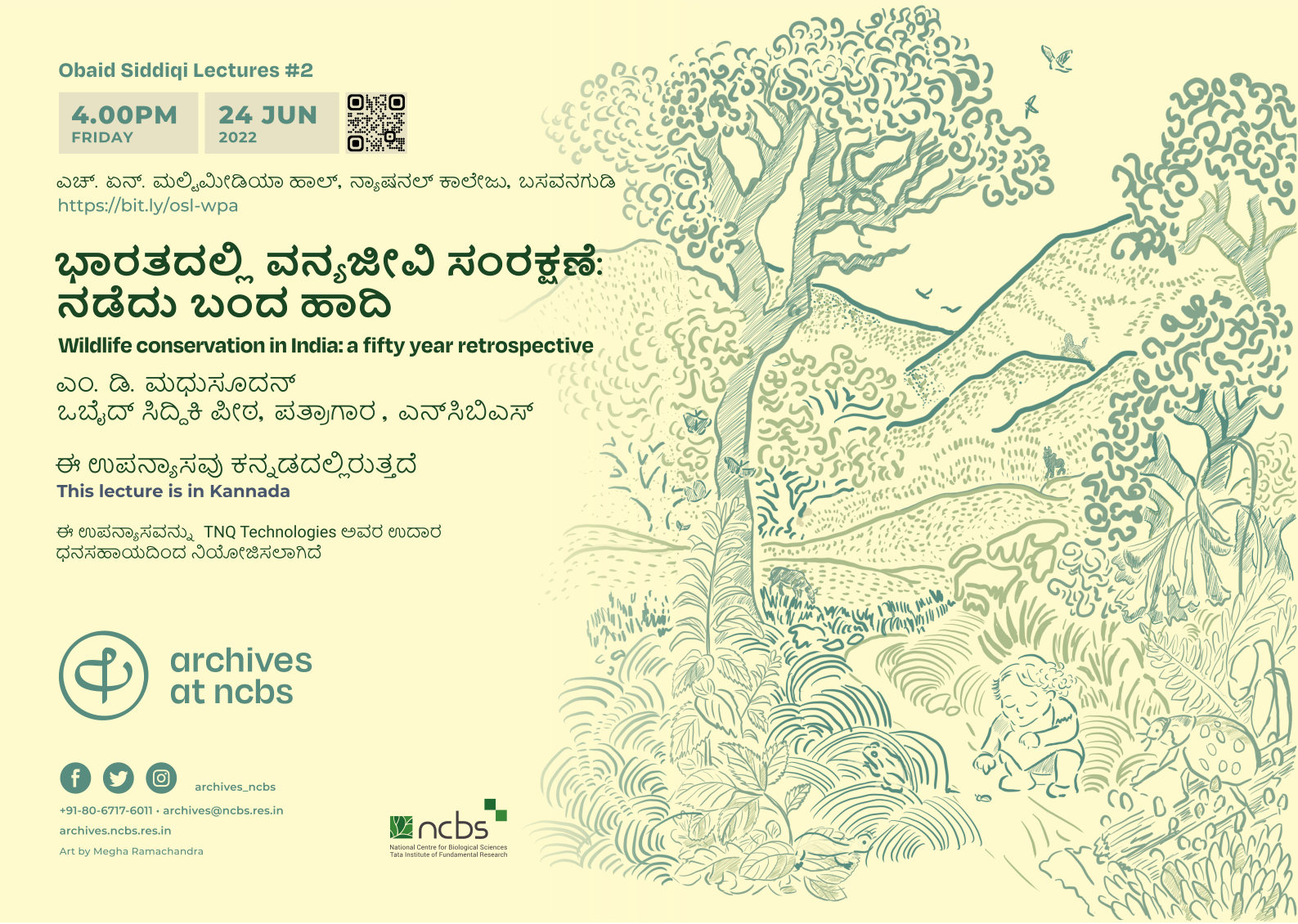Obaid Siddiqi Lectures - ಭಾರತದಲ್ಲಿ ವನ್ಯಜೀವಿ ಸಂರಕ್ಷಣೆ: ನಡೆದು ಬಂದ ಹಾದಿ (Wildlife conservation in India: a fifty year retrospective)
Archives at the National Centre for Biological Sciences
Obaid Siddiqi Lectures
Annual lectures delivered by the Obaid Siddiqi Chair in the History and Culture of Science at the Archives at NCBS.
ಭಾರತದಲ್ಲಿ ವನ್ಯಜೀವಿ ಸಂರಕ್ಷಣೆ: ನಡೆದು ಬಂದ ಹಾದಿ
Wildlife conservation in India: a fifty year retrospective
ಎಂ. ಡಿ. ಮಧುಸೂದನ್
ಒಬೈದ್ ಸಿದ್ದಿಕಿ ಪೀಠ. ಪತ್ರಾಗಾರ , ಎನ್ಸಿಬಿಎಸ್
MD Madhusudan
Obaid Siddiqi Chair, Archives at NCBS
Friday, Jun 24 2022. 4:00pm.
ಎಚ್. ಏನ್. ಮಲ್ಟಿಮೀಡಿಯಾ ಹಾಲ್, ನ್ಯಾಷನಲ್ ಕಾಲೇಜು
H.N. Multimedia Hall, National College, Basavanagudi
Details: https://bit.ly/osl-wpa
This lecture is in Kannada | ಈ ಉಪನ್ಯಾಸವು ಕನ್ನಡದಲ್ಲಿರುತ್ತದೆ
Free and open to the public
ಈ ಉಪನ್ಯಾಸವನ್ನು TNQ Technologies ಅವರ ಉದಾರ ಧನಸಹಾಯದಿಂದ ನಿಜೋಜಿಸಲಾಗಿದೆ
Made possible with generous support from TNQ Technologies.

Abstract:
1972ರ ಸೆಪ್ಟೆಂಬರ್ ತಿಂಗಳಲ್ಲಿ, ಭಾರತದ ಸಂಸತ್ತು ವನ್ಯಜೀವಿ (ರಕ್ಷಣೆ) ಮಸೂದೆಯನ್ನು ಕಾನೂನಾಗಿ ಅಂಗೀಕರಿಸಿ, ದೇಶದಲ್ಲಿ ಮೊದಲ ಬಾರಿಗೆ ವನ್ಯಜೀವಿ ಸಂರಕ್ಷಣೆಗೆ ರಾಷ್ಟ್ರೀಯ ಮಟ್ಟದಲ್ಲಿ ಪ್ರಾಮ್ಯುಖತೆ ನೀಡಿತು. ಇದರಿಂದ ಅಳಿವಿನಂಚಿನಲ್ಲಿರುವ ವನ್ಯಜೀವಿಗಳಿಗೆ ರಕ್ಷಣೆ ನೀಡಲು ಹಾಗು ಅವುಗಳ ಉಳಿವಿಗೆ ನಿರ್ಣಾಯಕವಾದ ಆವಾಸಸ್ಥಾನಗಳನ್ನು ಗುರುತಿಸಿ ಮೀಸಲಿಡಲು ಕಾನೂನಿನ ಆಧಾರ ಒದಗಿ, ಈ ಜವಾಬ್ದಾರಿಯನ್ನು ಒಂದು ಶತಮಾನದ ಹಿಂದೆ ಬ್ರಿಟಿಷರು ನಿರ್ಮಿಸಿದ್ದ ಅರಣ್ಯ ಇಲಾಖೆಗೆ ಒಪ್ಪಿಸಲಾಯಿತು. ಅದೇ ಸಮಯದಲ್ಲಿ, ಕುಸಿಯುತ್ತಿದ್ದ ಹುಲಿಯ ಚೇತರಿಕೆಗಾಗಿ ಟೈಗರ್ ಟಾಸ್ಕ್ ಫೋರ್ಸ್ ಒಂದನ್ನು ರಚಿಸಲಾಯಿತು. ವರ್ಷದೊಳಗೆ, ತೊಂದರೆಗೊಳಗಾದ ಹುಲಿಯುನ್ನು ನಮ್ಮ ರಾಷ್ಟ್ರೀಯ ಪ್ರಾಣಿಯನ್ನಾಗಿಸಿದ್ದಲ್ಲದೆ ಅದರ ಚೇತರಿಕೆಗೆ ಅಗತ್ಯವಾದ ರಾಜಕೀಯ ಸಂಕಲ್ಪ, ಕಾನೂನಿನ ಚೌಕಟ್ಟು ಮತ್ತು ಸ್ಪಷ್ಟ ಸಂರಕ್ಷಣಾ ಕ್ರಮ ಇವೆಲ್ಲವೂ ಹೊಸ ಹುಲಿಯೋಜನೆಯಲ್ಲಿ ಕೂಡಿ ಬಂತು. ಇದಲ್ಲದೆ ಇತರ ಆದ್ಯತೆಗಳೊಂದಿಗೆ ಪರಿಸರ ವನ್ಯಜೀವಿಗಳ ಸಂರಕ್ಷಣೆಯ ಅಗತ್ಯಗಳನ್ನು ಸಮನ್ವಯಗೊಳಿಸಲು ಒಂದು ರಾಷ್ಟ್ರೀಯ ಸಮಿತಿಯ ಸ್ಥಾಪನೆಯೂ ಆಯಿತು. ಅದೇ ವರ್ಷ ಸ್ಟೋಕ್ಹೋಮಿನಲ್ಲಿ ನಡೆದ ಮಾನವ ಪರಿಸರದ ಮೇಲಿನ UN ಸಮ್ಮೇಳನದಲ್ಲಿ, ಭಾರತದ ಪ್ರಧಾನಿ ಜಾಗತಿಕ ಮತ್ತು ರಾಷ್ಟ್ರೀಯ ಮಟ್ಟದಲ್ಲಿ ಪರಿಸರ ರಕ್ಷಣೆ ಮತ್ತು ಮನುಷ್ಯನ ಏಳಿಗೆ ಎರಡನ್ನೂ ಸಮನ್ವಯಗೊಳಿಸುವ ಉಭಯಸಂಕಟದ ಬಗ್ಗೆ ಧ್ವನಿ ಎತ್ತಿ ಮಾತನಾಡಿದರು. ಒಂದೇ ವರ್ಷದಲ್ಲಿ ಕಾಣಿಸೊಕೊಂಡ ಈ ಎಲ್ಲಾ ಬೆಳವಣಿಗೆಗಳು ಬರುವ ದಶಕಗಳಲ್ಲಿ ಭಾರತದ ವನ್ಯಜೀವಿ ಸಂರಕ್ಷಣೆಯ ರೂಪುರೇಖೆ ಹಾಗು ಕಾರ್ಯಗಳ ರಚನೆಗೆ ತಳಹದಿ ನೀಡಿದವು.
ಐವತ್ತು ವರ್ಷಗಳ ನಂತರ, ತನ್ನ ವನ್ಯಜೀವಿಗಳನ್ನು ರಕ್ಷಿಸುವ ಭಾರತದ ದೃಷ್ಟಿ ಮತ್ತು ಮಹತ್ವಾಕಾಂಕ್ಷೆ ಹೇಗೆ ಹೊರಹೊಮ್ಮಿದೆ? ಈ ಅವಧಿಯಲ್ಲಿ ನಾವು ಕಂಡಿರುವ ಯಶಸ್ಸು ಮತ್ತು ಹಿನ್ನಡೆಗೆ ಕಾರಣಗಳೇನು? ನಾವು 1972ರಲ್ಲಿ ಜನಕಲ್ಯಾಣ-ಆಧಾರಿತ ಅಭಿವೃದ್ಧಿಯ ರಾಜ್ಯವಾಗಿದ್ದೆವು. ಈಗ ನಿರಂತರ ಬೆಳವಣಿಗೆಯನ್ನು ಅನುಸರಿಸಿರುವ ಉದಾರವಾದಿ ಆರ್ಥಿಕತೆಯ ರಾಜ್ಯವಾಗಿದ್ದೇವೆ. ಈ ರೂಪಾಂತರದಲ್ಲಿ, ಯಾವ ಸಂರಕ್ಷಣಾ ಅವಕಾಶಗಳು ಮೂಡಿವೆ, ಯಾವ ಸವಾಲುಗಳು ಎದುರಾಗಿವೆ, ಹಾಗು ನಾವು ಅವುಗಳನ್ನು ಹೇಗೆ ಎದುರಿಸಿದ್ದೇವೆ? ಸಂರಕ್ಷಣೆಯ ಈ ಯಾನದಲ್ಲಿ ನಮ್ಮ ದೇಶದ ವೈವಿಧ್ಯಮಯ ಸಮಾಜ ಸಮುದಾಯಗಳ ಆಕಾಂಕ್ಷೆಗಳನ್ನು ಆತಂಕಗಳನ್ನು ನಾವು ಹೇಗೆ ಸಂಭೋದಿಸಿದ್ದೇವೆ? ಈ ಕೆಲವು ಪ್ರಶ್ನೆಗಳ ಮೂಲಕ ಭಾರತದ ವನ್ಯಜೀವಿ ಸಂರಕ್ಷಣೆಯ ವಿಮರ್ಶಾತ್ಮಕ ಚರಿತ್ರೆಯೆಡೆಗೆ ಈ ಉಪನ್ಯಾಸ ಒಂದು ಕಿರುಪ್ರಯತ್ನ.
Wildlife conservation in India: a fifty year retrospective
In September 1972, India’s parliament passed the Wildlife (Protection) Bill into law, giving nation-wide protection to wildlife for the first time ever. This brought the force of law to protect wild animals that were endangered and to protect habitats critical for their survival. The mandate of implementing this law was entrusted to the Forest Department, an institution created over a century earlier by the British. Around the same time, a Tiger Task Force was set up for the recovery of the tiger, which was in obvious decline. Within a year, not only had the tiger become our national animal, but also the political will, legal frameworks and conservation plan essential for its recovery were in place. A National Committee for Environmental Planning and Coordination was established to reconcile the needs of the environment with other socioeconomic priorities. At the UN Conference on Human Environment in Stockholm that same year, the Prime Minister of India spoke on the challenges of reconciling environmental protection with human well-being at global and national levels. These and other far-reaching actions India initiated in the early 1970s laid the foundation for its subsequent wildlife conservation efforts.
Fifty years on, how has India's vision and aspiration of protecting its wildlife turned out? What are some of the successes and setbacks characterising this period? As India went from being a welfare-focused development state to a liberal free-market economy in the pursuit of continuous economic growth, what opportunities and challenges have emerged for conservation, and how have we dealt with them? How have we managed to address the aspirations and anxieties of our country's diverse peoples whose lives intersect with the country’s wildlife conservation plans? Through these questions, this talk attempts to trace a critical history of wildlife conservation in India over the last fifty years.
Bio:
ಮಧು ಅವರು ಕಳೆದ ಮೂವತ್ತು ವರ್ಷಗಳಿಂದ ಪರಿಸರ ಶಾಸ್ತ್ರ ಮತ್ತು ವನ್ಯಜೀವಿ ಸಂರಕ್ಷಣೆಯ ವಿದ್ಯಾರ್ಥಿಯಾಗಿದ್ದಾರೆ. ಮಾನವ ಮತ್ತು ವನ್ಯಪ್ರಾಣಿಗಳ ನಡುವಿನ ಸಂಭಂದಗಳ ಬಗ್ಗೆ ಸಂಶೋಧನೆ ನಡೆಸಿದ್ದಾರೆ. ಹಲವು ವೈಜ್ಞಾನಿಕ ಬರಹಗಳನ್ನು ಬರೆದಿದ್ದಾರೆ. ವಿದ್ಯಾರ್ಥಿ-ವಿದ್ಯಾರ್ಥಿನಿಯರ ತರಬೇತಿ ಪೋಷಣೆಯಲ್ಲಿ ಭಾಗವಹಿಸಿದ್ದಾರೆ. ರೈತರು, ಅಧಿಕಾರಿಗಳು, ಆದಿವಾಸಿಗಳೂ ಸೇರಿದಂತೆ ವಿವಿಧ ವ್ಯಕ್ತಿಗಳೊಂದಿಗೆ ಮತ್ತು ಸಮೂಹಗಳೊಂದಿಗೆ ಸಂರಕ್ಷಣೆಯ ಪ್ರಯೋಗ-ಪ್ರಯತ್ನಗಳಲ್ಲಿ ಸಹಭಾಗಿಯಾಗಿದ್ದಾರೆ. ಮನುಷ್ಯ ಕಲ್ಯಾಣ ಮತ್ತು ವನ್ಯಜೀವಿ ಸಂರಕ್ಷಣೆ ಈ ಎರಡು ಆದ್ಯತೆಗಳ ನಡುವೆ ಸಮತೋಲನ ಅನುಸರಿಸುವ ನೀತಿಗಳ ರಚನೆಯಲ್ಲಿ, ನಿಯಮಗಳ ಅನುಷ್ಠಾನದಲ್ಲಿ ಭಾಗವಹಿಸಿದ್ದಾರೆ. ಈ ನಡುವೆ, ನೇಚರ್ ಕನ್ಸರ್ವೇಷನ್ ಫೌಂಡೇಶನ್ ಎಂಬ ಸಂಸ್ಥೆಯ ನಿರ್ಮಾಣ, ಬೆಳವಣಿಗೆ ಹಾಗು ನಿರ್ವಹಣೆಯಲ್ಲಿ ಇಪ್ಪತ್ತು ವರ್ಷಕ್ಕೂ ಹೆಚ್ಚು ಕಾಲ ತೊಡಗಿದ್ದರು. ಈಗ ಅವರು ಟಾಟಾ ಇನ್ಸ್ಟಿಟ್ಯೂಟ್ ಆಫ್ ಫಂಡಮೆಂಟಲ್ ರಿಸರ್ಚ್ ಸಂಸ್ಥೆಯ ನ್ಯಾಷನಲ್ ಸೆಂಟರ್ ಫಾರ್ ಬಯೋಲಾಜಿಕಲ್ ಸೈನ್ಸಸ್ ನಲ್ಲಿ ವಿಜ್ಞಾನದ ಚರಿತ್ರೆ ಮತ್ತು ಸಂಸ್ಕೃತಿಯ ಅಧ್ಯನನಕ್ಕಾಗಿ ಸ್ಥಾಪಿಸಿರುವ ಒಬೈದ್ ಸಿದ್ದಿಕಿ ಪೀಠದಲ್ಲಿ ಸೇವೆ ಸಲ್ಲಿಸುತ್ತಿದ್ದಾರೆ.
MD Madhusudan is a conservation scientist, who, for over two decades, has studied the interface between people and large wild animals, trained students, published papers, worked with individuals and collectives to mobilize conservation action, and participated in the making of policies striving to reconcile the needs of wildlife and of humans. Along the way, he helped establish, grow and manage Nature Conservation Foundation, a nonprofit that strives for knowledge-based and socially-responsible nature conservation across India. Madhu is currently the Obaid Siddiqi Chair in the History and Culture of Science at NCBS, working on a couple of projects that take a historical view of the science and practice of nature conservation in India.


